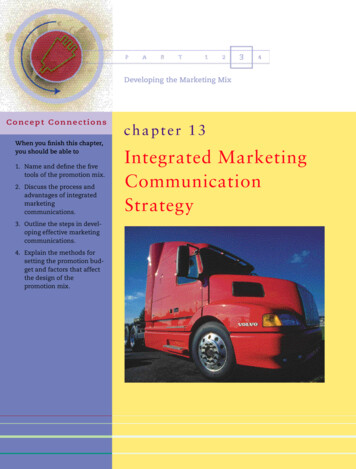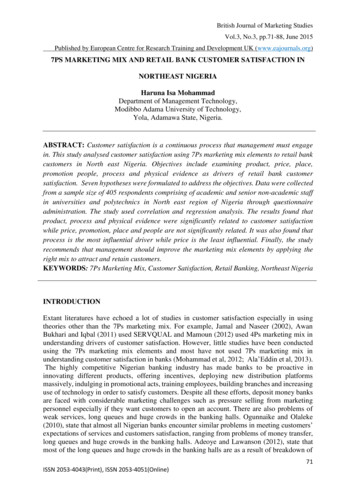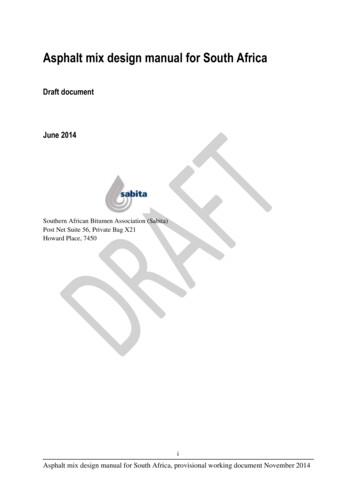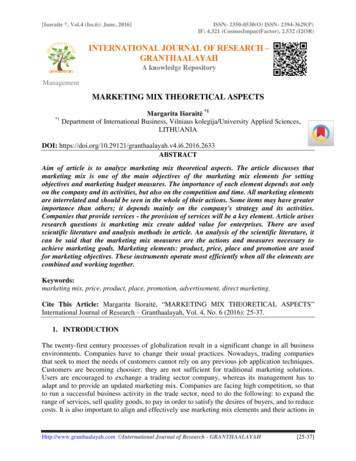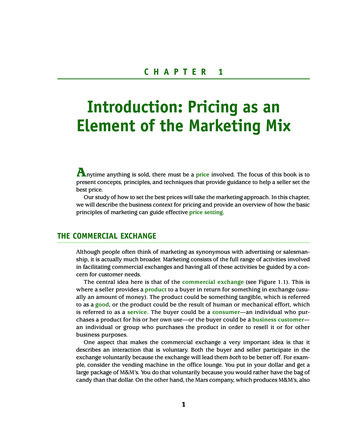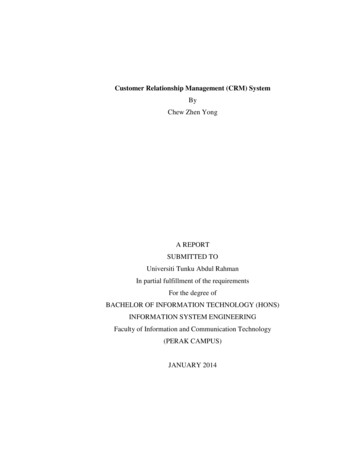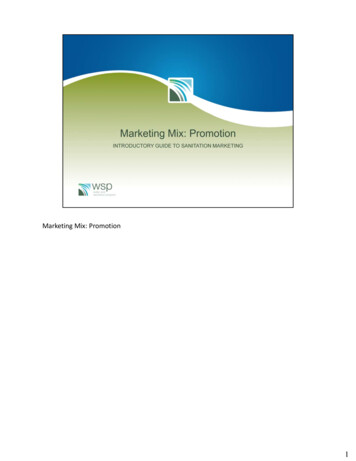
Transcription
Marketing Mix: Promotion1
The learning objectives for this module include understanding The steps to develop a marketing strategy What is meant by ‘marketing mix’ Guiding principles behind developing a promotion strategy Challenges in applying them to sanitation, and Some strategic options2
Once the results of the formative research are available, the next step is to identify goalsand develop the marketing strategy.Typically, the marketing strategy has a three to five year horizon and is supported byannual marketing plans that include a detailed action plan and timeline, a budget, andmonitoring plan.3
The sanitation marketing strategy is based on what is called the “Four Ps” of marketing orthe marketing mix.The Four P’s are product, price, promotion and place.4
Promotion refers to how you tell the audience about your product, price or place and eventhe target behavior.In many ways, promotion is the glue that binds the marketing mix together. It connectsmembers of the target audience with the behavior, and links suppliers and consumers.Promotion is also referred to as communication.5
Sanitation marketing often combines two approaches to promotion: branded advertisingand promotion and behavior change communication.Branding is an effective tool to standardize products, services, ideas, or behaviors and tocreate awareness of these at large scale.Branding can be used in various ways to promote improved sanitation– it might identify anopen‐defecationopendefecation free village or an accrediting suppliersupplier, or serve as a unifying elementacross the various components of a sanitation marketing campaign.6
For example, WSP worked with the local government in Himachal Pradesh, India, todevelop a logo to support the Total Sanitation Campaign.The logo, which shows an improved latrine inside a structure with a check‐mark, conveysthe message that individuals, families and entire communities can choose to feelembarrassment because of open defecation or pride and dignity through the use of atoilet.7
Districts can use the logo and related behavior change communication materials to supportCommunity‐Led Total Sanitation activities and to reinforce new social norms in districts thathave achieved open‐defecation‐free status.8
The second approach, behavior change communication, or BCC, aims to motivate people tomodify or adapt a targeted behavior.Here are some concepts and principles to keep in mind as you develop a communicationstrategy:9
First, promotion must be evidence‐based and build on insights from formative research.The goal is to be effective, not to win awards!10
Second, messages must be integrated across all communication channels. This can includeinterpersonal communication, mass media, and direct consumer contact or community‐wide events.An integrated approach will help ensure that messages are consistent, reinforce oneanother, and result in repeated exposure among the target audience. Avoid developingstand‐alone products.11
Third, advertising agencies have a role. They are experienced at designing anddisseminating communication products at large scale. Although their main expertise is incommercial advertising and promotion, ad agencies are increasingly knowledgeable aboutbehavior change approaches.12
What are some challenges?First, the capacity of ad agencies varies in each country and can change each year as staffturns over. Also, ad agencies tend to favor attractive or catchy creative approaches thatmay not respond to findings from the formative research. See Implementation for tips onhow to manage ad agencies.Second, developing evidenceSecondevidence‐basedbased communications takes time,time particularly if newformative research has to be conducted. This creates a challenge when you want tointegrate the sanitation marketing program with CLTS, which can be initiated relativelyquickly.13
Despite these challenges, there are some strategies to consider when developing yourpromotion strategy.Centrally developed, locally implemented behavior change communications can createeconomies of scale and help partners convey the same messages.For example, in East Java, WSP used findings from formative research to develop behaviorchange communication materials including an eighteight‐minuteminute video dramadrama, radio spots,spots andposters.These materials were introduced to representatives from 29 districts in a workshop. Acommunication tools menu, shown here, listed available resources in an easy‐to‐useformat. Participants were introduced to the materials and learned how to develop apromotion plan and budget.Since the training, more than 15 districts have used the materials, benefiting fromeconomies of scale.14
Another strategy is to integrate sanitation marketing and Community‐Led Total Sanitation,or CLTS.In Tanzania, a branded promotion strategy and behavior change communications wereready to implement soon after CLTS triggering took place. Choo Bora, which means “A goodtoilet is possible”, was used in posters, during direct consumer events, and by masons andsanitation committees.In theory, this type of integration could start even during the CLTS triggering process.15
This completes the overview. To learn more, please explore the entire module. You’ll findthe corresponding chapter, key terms and tips to keep in mind, and additional tools andresources.16
Sanitation marketing often combines two approaches to promotion: branded advertising and promotion and behavior change communication. Branding is an effective tool to standardize products, services, ideas, or b
